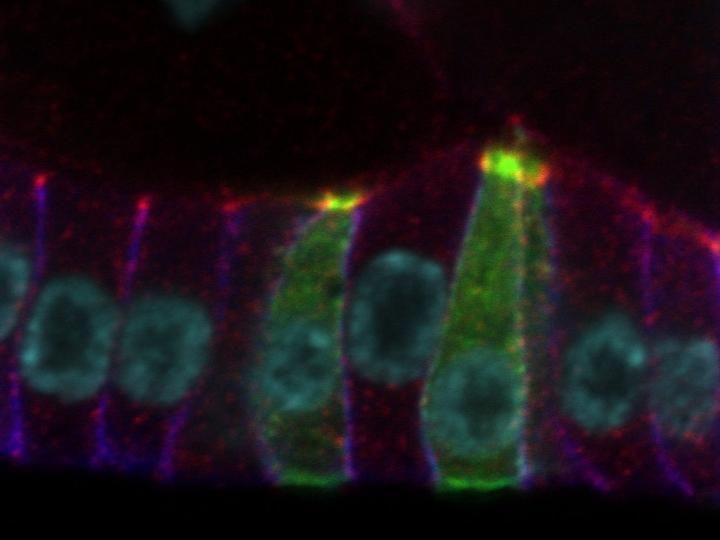How cells change their shape
Function of protein 'smallish' unraveled
Advertisement
During the development of an embryo, every single cell needs to know who it is, where it is, and what it has to do. Important is the polarity of the cell: Where is the top, where is the bottom, where are front and back? Only when the cell is polarized in the right way can it change the shape in exactly the way which is needed to form a certain structure or organ.

The protein Smallish (green) was produced in huge amounts in single cells of the fruit fly Drosophila. This causes constriction of the cells at the upper end, resulting in triangular shape of the cells when viewed from the side. The image was taken with a Zeiss LSM 880 confocal microscope with Airyscan detector at the Institute for Anatomy of Cologne University Hospital.
Irina Peek & Andreas Wodarz
Good things take time - breakthrough after 20 years of research
The polarity of cells is controlled by a relatively small group of genes, which remained almost unchanged in all higher animals over millions of years. "Almost twenty years ago, my first PhD-student found an interesting, unnamed gene, which was likely participating in the polarity," says Prof. Andreas Wodarz from CECAD. The first tests were promising - even though the gene turned out to be very mutable. In the beginning, the gene seemed to code for a mid-sized protein of about 900 amino acids. By and by it became clear that the gene is much bigger in reality and holds information for a protein almost twice the size. After all, it was possible to knock out the protein in the fly drosophila - but surprisingly the mutated animals where viable. "Most of the genes important for polarity are essential and organisms without them cannot live. Because the result did not fit our expectations, the gene ended up in the drawer for a while," Wodarz explains.
Almost ten years later, another doctoral candidate, Hamze Beati, conducted experiments that provided first hints towards the functioning of the gene. Beati produced a transgenic strain of flies, which produced excess of the protein in cells. The result was astonishing: The cells changed their form and contracted at the top. Observed from above, the cells looked significantly smaller, which resulted in the name for the gene: "smallish." The contradiction was obvious. On the one hand, smallish had great influence on the shape of the cells, but mutant flies where still able to live without it. How could this be?
Gene products are stored in the egg cells
Irina Peek, doctoral student number three and co-first author of the publication, made the breakthrough in 2016. She found the reason why flies where able to live with the gene knocked out: there was a store of functioning smallish-proteins in the egg cell. In smallish mutant embryos where the mother generation was already mutant and could not store proteins in the egg cell, shape generation was out of control. "Smallish is important for the correct shape of the cells. In embryos completely missing smallish, we see that the cells are loose and do not have tension anymore," says Irina Peek. "Those cells are not able to perform coordinated cell shape changes, which are essential for shape generation."
The gene is not only interesting for basic research. "The gene is highly conserved across evolution, which means it can be found in similar ways in many organisms. The human homolog LMO7 is known as a tumor suppressor. In a range of tumors reduced amounts of LMO7 were shown, which indicates a function in the growth control of tumors," Andreas Wodarz adds. In upcoming experiments, the researchers want to investigate how smallish interacts with other proteins, how it gets to the right place in the cell, and how it influences the shape. One thing is for sure: smallish will not be put back in the drawer anytime soon.
Original publication
Beati, Hamze and Peek, Irina and Hordowska, Paulina and Honemann-Capito, Mona and Glashauser, Jade and Renschler, Fabian A. and Kakanj, Parisa and Ramrath, Andreas and Leptin, Maria and Luschnig, Stefan and Wiesner, Silke and Wodarz, Andreas; "The adherens junction–associated LIM domain protein Smallish regulates epithelial morphogenesis"; J Cell Biol; 2018























































